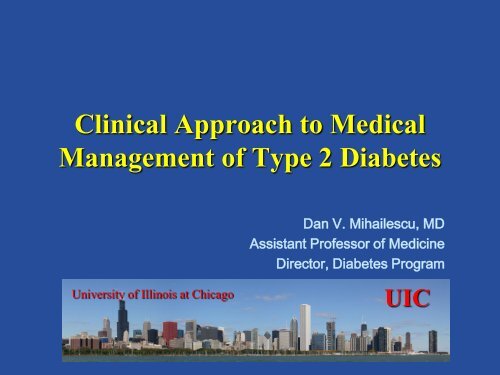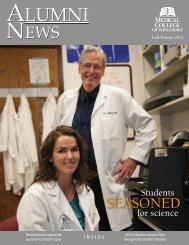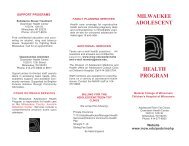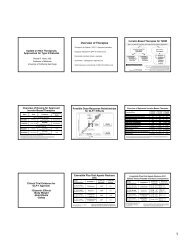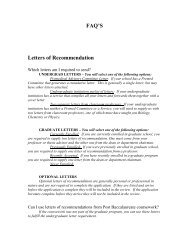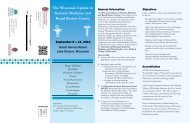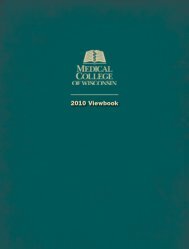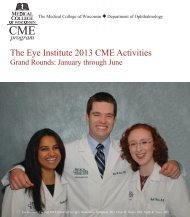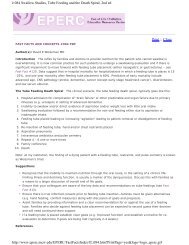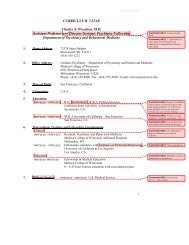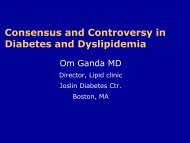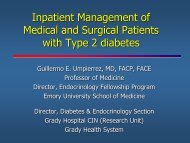Clinical Approach to Medical Management of Type 2 Diabetes
Clinical Approach to Medical Management of Type 2 Diabetes
Clinical Approach to Medical Management of Type 2 Diabetes
Create successful ePaper yourself
Turn your PDF publications into a flip-book with our unique Google optimized e-Paper software.
<strong>Clinical</strong> <strong>Approach</strong> <strong>to</strong> <strong>Medical</strong><br />
<strong>Management</strong> <strong>of</strong> <strong>Type</strong> 2 <strong>Diabetes</strong><br />
Dan V. Mihailescu, MD<br />
Assistant Pr<strong>of</strong>essor <strong>of</strong> Medicine<br />
Direc<strong>to</strong>r, <strong>Diabetes</strong> Program<br />
University <strong>of</strong> Illinois at Chicago<br />
UIC
Disclosures:<br />
• The Speaker has no financial conflict <strong>of</strong><br />
interest <strong>to</strong> declare<br />
• The Speaker is not a consultant with any<br />
pharmaceutical company
Outline:<br />
1. Glycemic Targets in <strong>Type</strong> 2 <strong>Diabetes</strong><br />
2. Overview <strong>of</strong> Antihyperglycemic Agents<br />
3. Treatment Guidelines for <strong>Type</strong> 2<br />
<strong>Diabetes</strong>
Glycemic Goals <strong>of</strong> Therapy in<br />
Outpatient Settings<br />
ADA<br />
AACE<br />
HBA1c < 7% < 6.5%<br />
Fasting BG<br />
Pre-prandial BG<br />
70-130 mg/dl<br />
< 110 mg/dl<br />
Post-meal BG < 180 mg/dl < 140 mg/dl<br />
DIABETES CARE, 35, SUPPLEMENT 1, JANUARY 2012<br />
ACE/AACE <strong>Diabetes</strong> Road Map Task Force. Endocr Pract. 2007
Glycemic Goals <strong>of</strong> Therapy in<br />
Outpatient Settings<br />
• Both sets <strong>of</strong> recommendations are based on the<br />
same clinical trial data, primarily UKPDS and<br />
DCCT trials<br />
• Both trials showed a decrease in the rate <strong>of</strong><br />
microvascular complications in the intensive<br />
control arm ( achieved A1c 7% in UKPDS and<br />
7.1% in DCCT trials)<br />
• What about more recent trials?
Glycemic Control Strategies:<br />
Conventional vs. Intensive<br />
A1c<br />
(%)<br />
Microvascular<br />
Complications<br />
Macrovascular<br />
Complications<br />
Mortality<br />
ADVANCE<br />
(N=5571, age~66)<br />
6.5 vs 7.3<br />
(Nephropathy)<br />
ACCORD<br />
(N=10,250, age~62)<br />
6.4 vs 7.5 Composite<br />
(Retinopathy)<br />
VADT<br />
6.9 vs 8.4<br />
(N=892, age~60)<br />
UKPDS<br />
7.0 vs 7.9<br />
(N=4000, age~53)
Adjusted Hazard Ratio for <strong>Clinical</strong> Events in<br />
ADVANCE Trial<br />
End Point<br />
Major<br />
Macrovascular Event<br />
Major Microvascular<br />
Event<br />
Severe Hypoglycemia,<br />
N=231, (%)<br />
No Severe<br />
Hypoglycemia,<br />
N=10909, (%)<br />
HR (95% CI)<br />
15.9 10.2 3.5 (2.4-5.1)<br />
11.5 10.1 2.2 (1.4-3.4)<br />
All Cause Mortality 19.5 9.0 3.3 (2.3-4.6)<br />
Cardiovascular<br />
Mortality<br />
Noncardiovascular<br />
Mortality<br />
9.5 4.8 3.8 (2.4-6)<br />
10 4.3 2.8 (1.6-4.8)<br />
Zoungas et al, NEJM, 2010
Benefit assessment <strong>of</strong> long-term blood<br />
glucose lowering <strong>to</strong> near-normal levels in<br />
patients with type 2 diabetes mellitus<br />
• Systematic review <strong>of</strong> seven<br />
RCT including 28,000<br />
patients with type 2 DM<br />
– ACCORD<br />
– ADVANCE<br />
– VADT<br />
– UKPDS<br />
– KUMAMOTO<br />
– UGDP<br />
– Van der Does<br />
• The primary outcome was<br />
all-cause mortality<br />
• Secondary outcomes were<br />
late complications (MI,<br />
stroke, ESRD, amputation,<br />
blindness, therapy-related<br />
fac<strong>to</strong>rs in terms <strong>of</strong> severe<br />
hypoglycemia and serious<br />
adverse advents)<br />
Institute for Quality and Efficiency in Health Care Report No. A05-07, 2011
Benefit assessment <strong>of</strong> long-term blood<br />
glucose lowering <strong>to</strong> near-normal levels in<br />
patients with type 2 diabetes mellitus<br />
• A benefit or harm <strong>of</strong> intensive BG lowering was not<br />
proven for any <strong>of</strong> the patient-relevant investigated<br />
outcomes – mortality or diabetes-related<br />
complications (fatal or non-fatal MI, fatal or non-fatal<br />
stroke, ESRD, amputation, or blindness)<br />
• The data provide indications <strong>of</strong> harm through an<br />
increased rate <strong>of</strong> severe hypoglycemia and serious<br />
adverse events independent <strong>of</strong> hypoglycemia<br />
Institute for Quality and Efficiency in Health Care Report No. A05-07, 2011
A1C Goal < 7%<br />
7%<br />
Inzucchi et al, www.care.diabetesjournals.org, accessed April 23, 2012
Outline:<br />
1. Glycemic Targets in <strong>Type</strong> 2 <strong>Diabetes</strong><br />
2. Properties <strong>of</strong> Selected Therapeutic<br />
Agents<br />
3. Treatment Guidelines for <strong>Type</strong> 2<br />
<strong>Diabetes</strong>
Antihyperglycemic Agents<br />
1. Biguanides (Metformin)<br />
2. Sulfonylurea<br />
3. Meglitinides<br />
4. Insulins<br />
5. Thiazolidinediones (TZDs)<br />
6. Dipeptidyl Peptidise-4 (DPP4) Inhibi<strong>to</strong>rs<br />
7. Glucagon-Like Peptide 1 (GLP1) Analogues<br />
8. Alpha-Glucosidase Inhibi<strong>to</strong>rs<br />
9. Colesevelam<br />
10. Bromocriptine<br />
11. Amylin agonists
<strong>Type</strong> 2 DM Treatment – Practical Tips:<br />
• All oral agents require presence <strong>of</strong> functioning<br />
Beta-cells as they work by either increasing<br />
their function or enhancing insulin sensitivity<br />
• Higher baseline A1c levels predicts a greater<br />
drop in A1c<br />
• Shorter duration <strong>of</strong> diabetes predicts greater<br />
drop in A1c level
• Diet, exercise, and education remain the foundation<br />
<strong>of</strong> any type 2 diabetes treatment program<br />
• Lifestyle Modifications Decrease HbA1c by 1-2%<br />
• Lifestyle management is the most difficult<br />
prescription that I write…
The Biguanides:<br />
Basic Characteristics <strong>of</strong> Metformin<br />
Mechanism: Decreases hepatic glucose production<br />
by activating AMP-kinase<br />
Power: Decreases HbA 1c ~ 1.5%<br />
Dosing:<br />
One <strong>to</strong> three times daily<br />
(aim for 2000 mg daily)<br />
Side effects: Diarrhea, nausea (start low), low B12<br />
Main risk: Lactic acidosis, very rare (1/3000<br />
patient-years)<br />
Limitations: Cr < 1.5 (M), < 1.4 (F),<br />
(Canada Cr cl > 60)
Relative risk reduction for<br />
metformin treatment (%)<br />
UKPDS 34: relative risk reduction with<br />
metformin vs conventional treatment<br />
0<br />
10<br />
20<br />
30<br />
40<br />
50<br />
-32<br />
**<br />
-42<br />
*<br />
-36<br />
*<br />
-39<br />
-41<br />
*<br />
* p < 0.05 ** p < 0.01<br />
N=1704<br />
patients<br />
Lancet 1998;352:854–65
10-Year Follow-up <strong>of</strong> Intensive control in <strong>Type</strong> 2 DM<br />
Hazard Ratios for Prespecified <strong>Clinical</strong> Outcomes<br />
Holman R et al. N Engl J Med 2008
Metformin: Old Drug, New Targets<br />
Libby et al, <strong>Diabetes</strong> Care, 2009<br />
• Observational Cohort Study<br />
in U.K.<br />
–4085 DM2 on MF<br />
–4085 DM2 compara<strong>to</strong>rs (matched<br />
<strong>to</strong> the yr <strong>of</strong> DM diagnosis)<br />
• Primary outcome:<br />
–Diagnosis <strong>of</strong> Cancer<br />
–297 cases (7.3%) MF group<br />
–474 cases (11.6%) Compara<strong>to</strong>rs<br />
• Secondary outcomes:<br />
– Diagnosis <strong>of</strong> colon, lung,<br />
breast cancer<br />
– All cause and cancer mortality
Metformin: Old Drug, New Targets<br />
Libby et al, <strong>Diabetes</strong> Care, 2009
Metformin Versus Active Compara<strong>to</strong>rs<br />
Study<br />
Characteristics<br />
N=289, 33 weeks,<br />
baseline A1c 8.2-8.4%<br />
N=486, 16 weeks,<br />
baseline A1c 8.5-8.8%<br />
N=1199, 52 weeks,<br />
baseline A1c 8.7%<br />
N=1091, 24 weeks,<br />
baseline A1c 8.6-8.8%<br />
N=820, 26 weeks<br />
baseline A1c 8.4-8.6%<br />
Metformin<br />
or Placebo<br />
A1c Effect<br />
Metformin<br />
vs. Placebo -1.4% +0.4%<br />
vs. Glyburide<br />
vs. Glyburide/Metformin<br />
-1.5% -1.9%<br />
-2.3%<br />
vs. Pioglitazone -1.5% -1.4%<br />
vs. Sitagliptin<br />
vs. Sitagliptin/Metformin<br />
vs. Exenatide LAR<br />
vs. Sitagliptin<br />
vs. Pioglitazone<br />
-1.13%<br />
(max dose)<br />
A1c Effect<br />
Compara<strong>to</strong>r<br />
-0.66%<br />
-1.90%<br />
-1.5% ExeLAR -1.5%<br />
Sita -1.2%<br />
Pio -1.6%<br />
1. Defronzo et al, NEJM, 1995 2.Garber et al, JCEM, 2003 3. Schernanter et al, JCEM, 2004<br />
4.Goldstein et al, <strong>Diabetes</strong> Care, 2007. 5.Russel-Jones et al, <strong>Diabetes</strong> Care, 2012
Secretagogues:<br />
Sulfonylureas and the Meglitinides<br />
Mechanism:<br />
Depend upon:<br />
Increase basal and postprandial<br />
insulin secretion<br />
Functioning -cells, bind <strong>to</strong> different<br />
recep<strong>to</strong>rs<br />
Power: Decrease HbA 1c ~1.5%<br />
Dosing:<br />
Side effects:<br />
Main risk:<br />
Once <strong>to</strong> three times daily<br />
Weight gain<br />
Hypoglycemia, especially if CKD
Insulin Secretagogues – Classification:<br />
1. First Generation Sulfonylureas<br />
• Chlorpropramide<br />
2. Second Generation Sulfonylureas<br />
• Glibenclamide (Glyburide)<br />
• Glipizide<br />
• Glimepiride<br />
3. Meglitinides<br />
• Repaglinide (Prandin)<br />
• Nateglinide (Starlix)
Secretagogues:<br />
Sulfonylureas and the Glinides<br />
• Avoid using first generation SU agents and Glyburide<br />
- higher risk <strong>of</strong> hypoglycemia, especially in elderly<br />
(partially active metabolites)<br />
• Glimepiride -significant biliary and fecal excretion <strong>of</strong><br />
the metabolites<br />
• For patients with CKD or with unpredictable meal<br />
schedule use meglitinides BID - TID with meals
10-Year Follow-up <strong>of</strong> Intensive control in<br />
<strong>Type</strong> 2 DM (Holman et al, NEJM, 2008)
Sulfonylurea Versus Newer Agents:<br />
Glimepiride and Sitagliptin<br />
Srivastava et al, JAPI, 2012
Sulfonylurea Versus Newer Agents:<br />
Glimepiride and Liraglutide<br />
• Minor Hypoglycemia: 3% Liraglutide vs. 17% Glimepiride<br />
• No Major Hypoglycemia was reported in any groups<br />
• Nausea: 19% Liraglutide vs. 4% Glimepiride<br />
Nauck et al, <strong>Diabetes</strong> Care, 2009 (LEAD 2)
Basic Characteristics <strong>of</strong> Glitazones<br />
• Enhance muscle and adipose tissue response <strong>to</strong><br />
insulin, modulate PPAR-γ recep<strong>to</strong>r<br />
• Depends upon presence <strong>of</strong> insulin, appear <strong>to</strong> have a<br />
more durable effect on the glycemic control<br />
compared with SU<br />
• Decrease HbA 1c ~ 1.0 %<br />
• Side effects: edema, CHF, weight gain, bone<br />
fractures
Rosiglitazone<br />
• Rosiglitazone is associated<br />
with an increased risk <strong>of</strong> CV<br />
events, removed from the<br />
market in Europe, use<br />
restricted by the FDA<br />
– Must prove other medications<br />
are not effective or<br />
Rosiglitazone is the only<br />
alternative<br />
Nissen et al, Arch Intern Med, 2010
Pioglitazone<br />
• Is not associated with an increased CV risk<br />
• Is associated with an increased risk <strong>of</strong> urinary bladder<br />
cancer<br />
– removed from the market in France, Germany<br />
recommended not <strong>to</strong> be started in new patients<br />
– FDA (August 2011): “Interim results…suggested that<br />
taking ACTOS longer than 12 months increased the<br />
relative risk <strong>of</strong> developing bladder cancer…by 40% which<br />
equates <strong>to</strong> an absolute increase <strong>of</strong> 3 cases in 10,000 (from<br />
approximately 7 in 10,000 [without ACTOS] <strong>to</strong><br />
approximately 10 in 10,000 [with ACTOS])”
Pioglitazone<br />
• Durable Glycemic Control<br />
• Favorable Lipid Effects<br />
( TG, HDL)<br />
• Possible CVD Risk Reduction<br />
• CHF<br />
• Bone Fractures<br />
• Edema<br />
• Bladder Cancer
The α-Glucosidase Inhibi<strong>to</strong>rs:<br />
Basic Characteristics <strong>of</strong> Acarbose and<br />
Migli<strong>to</strong>l<br />
Mechanism <strong>of</strong> action: Delays carbohydrate<br />
absorption<br />
Targets:<br />
Postprandial<br />
hyperglycemia<br />
Strength: Decrease HbA 1c 0.5 - 1%<br />
Dosing:<br />
Three times daily<br />
Side effects: Flatulence<br />
Main risk: LFT elevation (rare)<br />
4-7
STOP-NIDDM Trial<br />
To evaluate the effect <strong>of</strong> decreasing postprandial hyperglycemia<br />
with acarbose on the risk <strong>of</strong> CVD and HTN in patients with IGT<br />
N=1429<br />
RRR 49%<br />
Chiasson et al, JAMA, 2003
<strong>Type</strong>s <strong>of</strong> Insulins<br />
• Basal insulin<br />
– Human: NPH<br />
– Analogs: glargine, detemir<br />
• Mealtime insulin<br />
– Short acting (human): regular<br />
– Rapid acting (analog): aspart, lispro, glulisine<br />
• Premixed insulins<br />
– Provide both basal and mealtime cover<br />
– Multiple combinations: Humalog75/25; Humalog50/50;<br />
Novolog70/30; Human 70/30<br />
• Concentrated Insulin: U500
Treat <strong>to</strong> Target in <strong>Type</strong> 2 <strong>Diabetes</strong> Trial<br />
• 708 patients not controlled<br />
with MF or SU<br />
• Duration – 3 years<br />
• Baseline A1c 8.3%<br />
• Treatment groups:<br />
– Basal insulin QD/BID (detemir)<br />
– Prandial insulin TID (aspart)<br />
– Biphasic insulin BID/TID<br />
(NovologMix 70/30)<br />
A1c 6.9%<br />
Holman et al, NEJM, 2009
Prandial Versus Basal Insulin: The HEART2D Trial<br />
.<br />
N=1115 patients post MI<br />
- 558 Basal Group<br />
(NPH or Glargine)<br />
- 557 Prandial Group<br />
(Lispro)<br />
- Mean age ~ 61yrs<br />
- <strong>Diabetes</strong> ~ 9 yrs<br />
Primary Outcome: Time <strong>to</strong><br />
the first combined<br />
cardiovascular event<br />
Raz et al. <strong>Diabetes</strong> Care 2009
Prandial Versus Basal Insulin: The HEART2D Trial<br />
Raz et al. <strong>Diabetes</strong> Care, 2009
Insulin Initiation and Titration<br />
• Start with a Basal Insulin<br />
(<strong>Type</strong> 2 <strong>Diabetes</strong>)<br />
• Either NPH, Glargine or Detemir<br />
• Begin at 10 units or 0.2 units/Kg<br />
• Dose titration (2-3 units every 3 days) till fasting BG<br />
are in the “target range” (ADA, 70-130 mg/dl)<br />
– If hypoglycemia occurs reduce dose by 10-15% (min 4<br />
units)<br />
• If A1c is not at goal after achieving the target fasting<br />
level, add one dose <strong>of</strong> Rapid Insulin before the main<br />
meal (starting at 4-6 units)<br />
Adapted from Nathan et al, <strong>Diabetes</strong> Care, 2009
Colesevelam<br />
• Bile acid sequestrant with antidiabetic properties<br />
– A1c reduction ~ 0.5%<br />
– Dose: 3.75 g daily or 1.875 g PO BID<br />
– Used in combination with diet, oral agents or insulin<br />
• Lipid Effects:<br />
– Positive: reduction <strong>of</strong> the LDL levels ~ 15%<br />
– Negative: increase TG levels ~ 20% in combination with SU<br />
and insulin<br />
• Interfere with absorption <strong>of</strong> several drugs: OCPs,<br />
levothyroxine, cyclosporine, glyburide, warfarin, pheny<strong>to</strong>in
Colesevelam vs. Placebo in combination<br />
with metformin, sulfonylurea and insulin<br />
Study<br />
Characteristics<br />
Colesevelam<br />
A1c Effect<br />
Colesevelam<br />
A1c Effect<br />
Placebo<br />
N=461, 26 weeks,<br />
baseline A1c 8.2-8.3%<br />
N=316, 26 weeks,<br />
baseline A1c 8.1-8.2%<br />
N=287, 16 weeks,<br />
baseline A1c 8.3%<br />
vs. Placebo<br />
(add-on <strong>to</strong> SU)<br />
vs. Placebo<br />
(add-on <strong>to</strong> MF)<br />
vs. Placebo<br />
(add-on <strong>to</strong> Insulin)<br />
-0.3% +0.2%<br />
-0.39% +0.15%<br />
-0.4% +0.1%<br />
1. Fonseca et al, <strong>Diabetes</strong> Care, 2008<br />
2. Bays et al, Arch Intern Med, 2008<br />
3. Goldberg et al, Arch Intern Med, 2008
Bromocriptine<br />
• Ergot-derived dopamine agonist, unknown antidiabetic<br />
mechanism (presumably by increasing the hypotalamic<br />
dopamine levels and decreasing SNS activity)<br />
– A1c reduction ~0.4%<br />
– Dose 0.6-4.8 mg PO daily in AM within 2 hrs after waking<br />
– SE: nausea, dizziness, HA, syncope<br />
Bromocriptine<br />
N=80<br />
(1.6-4.8 mg/day)<br />
Placebo<br />
N=79<br />
HbA1c (%)<br />
•Baseline 9.0 8.8<br />
•Change from baseline -0.1 +0.3<br />
•Difference from placebo -0.4<br />
http://www.accessdata.fda.gov/drugsatfda_docs/label/2009/020866lbl.pdf, accessed 04/04/2012
Cycloset Safety Trial<br />
HR Bromocriptine QR vs. placebo: 0.60 (CI 0.37-0.96)<br />
Composite Cardiovascular Endpoint – time <strong>to</strong> first MI, stroke, CABG,<br />
hospitalization for unstable angina or CHF<br />
Gaziano et al, <strong>Diabetes</strong> Care, 2010
Pramlintide<br />
• Synthetic analogue <strong>of</strong> amylin witch is synthesized by<br />
beta-cells and released with insulin<br />
• Mechanism <strong>of</strong> action: decreases glucagon release,<br />
slows gastric emptying, and decreases food intake<br />
• Approved for use in patients who are taking mealtime<br />
insulin alone or in combination with MF and/or SU<br />
• Dose (DM2): Initiate at 60 mcg before meals and<br />
increase <strong>to</strong> 120 mcg if <strong>to</strong>lerated<br />
• Main SE: nausea and hypoglycemia (reduce mealtime<br />
dose by 50% when initiating PRA)
• N=656<br />
• DM2 for ~12 yrs<br />
• BMI ~ 34<br />
• Baseline A1c 9.0-9.3%<br />
N=161<br />
N=171<br />
N=166<br />
Hollander et al, <strong>Diabetes</strong> Care, 2003
Outline:<br />
1. Glycemic Targets in <strong>Type</strong> 2 <strong>Diabetes</strong><br />
2. Properties <strong>of</strong> Selected Therapeutic<br />
Agents<br />
3. Treatment Guidelines for <strong>Type</strong> 2<br />
<strong>Diabetes</strong>
So, we have 11 different classes <strong>of</strong><br />
antihyperglycemic agents, 9 approved<br />
for use as monotherapy…<br />
• C (n, r) = n!/r!(n-r)!<br />
• Monotherapy – 9 possible options<br />
• Dual Therapy – 45 possible combinations<br />
• Triple Therapy – 240 possible combinations
Treatment Guidelines for <strong>Type</strong> 2 DM<br />
• 2008 AACE/ACE Road Map<br />
• 2008 Canadian <strong>Diabetes</strong> Association <strong>Clinical</strong> Practice<br />
Recommendations<br />
• 2009 AACE/ACE Treatment Algorithm<br />
• 2009 American <strong>Diabetes</strong> Association (ADA)/<br />
European Association for the Study <strong>of</strong> <strong>Diabetes</strong><br />
(EASD)<br />
• 2012 Position Statement <strong>of</strong> the ADA and EASD
Comparative Effectiveness and Safety <strong>of</strong> Medications for <strong>Type</strong> 2<br />
<strong>Diabetes</strong>: An Update Including New Drugs and 2-Drug Combinations<br />
Bennett W L et al. Ann Intern Med<br />
doi:10.1059/0003-4819-154-9-201105030-00336<br />
©2011 by American College <strong>of</strong> Physicians
Strength <strong>of</strong> Evidence for the Comparative Effectiveness and Safety <strong>of</strong> <strong>Diabetes</strong><br />
Medications as Monotherapy and Combination Therapy on Long-Term <strong>Clinical</strong> Outcomes<br />
Bennett W L et al. Ann Intern Med<br />
doi:10.1059/0003-4819-154-9-201105030-00336<br />
©2011 by American College <strong>of</strong> Physicians
Pooled between-group differences in HbA1c level with<br />
monotherapy and combination therapies<br />
Bennett W L et al. Ann Intern Med<br />
doi:10.1059/0003-4819-154-9-201105030-00336<br />
©2011 by American College <strong>of</strong> Physicians
Effect <strong>of</strong> Antihyperglycemic Agents Added <strong>to</strong> Metformin<br />
and a Sulfonylurea on Glycemic Control and Weight<br />
Gain in <strong>Type</strong> 2<strong>Diabetes</strong>: A Network Meta-analysis<br />
• To evaluate the effect <strong>of</strong> the THIRD antihyperglycemic<br />
agents in the reduction <strong>of</strong> HbA1c level, change in body<br />
weight, and the frequency <strong>of</strong> severe hypoglycemic events<br />
• Meta-analysis <strong>of</strong> 18 trials, 4535 participants<br />
• Mean duration <strong>of</strong> follow-up 31 weeks (26 -52 weeks)<br />
• Duration <strong>of</strong> diabetes 7.5 – 13.1 years<br />
• Baseline A1c 7.5 – 10.6%<br />
Gross et al, Ann Intern Med, 2011
Effect <strong>of</strong> Antihyperglycemic Agents Added <strong>to</strong> Metformin<br />
and a Sulfonylurea on Glycemic Control and Weight<br />
Gain in <strong>Type</strong> 2<strong>Diabetes</strong>: A Network Meta-analysis<br />
Gross et al, Ann Intern Med, 2011
<strong>Type</strong> 2 <strong>Diabetes</strong>: Assessing the Relative<br />
Risks and Benefits <strong>of</strong> Glucose-lowering<br />
Medications<br />
Richard M. Bergenstal, MD, Clifford J. Bailey, PhD David<br />
M. Kendall, MD<br />
International <strong>Diabetes</strong> Center, Minneapolis, Minn; <strong>Diabetes</strong><br />
Research, Life and Health Sciences, As<strong>to</strong>n University,<br />
Birmingham, UK.<br />
The American Journal <strong>of</strong> Medicine (2010) 123, 374.<br />
Figure 4 Events per 1000 patient-years for representative endpoints. Black bars indicate excess risk <strong>of</strong> events in diabetes patients relative<br />
<strong>to</strong> nondiabetic subjects;19,75,85,86 gray bars indicate excess risk <strong>of</strong> events in patients treated with specific glucose- lowering medications<br />
relative <strong>to</strong> diabetic patients on other agents;2,25,41,54,60,61,74 and white bars indicate the decreased risk <strong>of</strong> events in patients undergoing<br />
intensive glucose control policies. Foley RN et al. J Am Soc Nephrol. 2005;16(2):489-495; b = 19Haffner SM et al. N Engl J<br />
Med.1998;339(4)229-234; c = 75Noel RA et al. <strong>Diabetes</strong> Care. 2009;32(5):834-838;d = 86Trautner C et al. <strong>Diabetes</strong> Care. 1997;20(7):1147-1153; e =<br />
60,61Hamp<strong>to</strong>nT. JAMA. 2007;297(15):1645 and Meier C et al. Arch Intern Med. 2008;168(8):820-825; f = 41Lago RM et al. Lancet.<br />
2007;370(9593):1129-1136; g = 25Patel A et al. N Engl J Med. 2008;358(24):2560-2572; h = 2Nissen SE, Wolski K. N Engl J Med.<br />
2007;356(24)2457-2471; i = 54Glucophage [package insert]. Prince<strong>to</strong>n, NJ: Bris<strong>to</strong>l-Myers Squibb Company; 2006; j = 74Dore DD et al.
Yearly Cost for Different Antihyperglycemic<br />
Agents Adjusted for 1% Reduction in A1c<br />
AGENT<br />
COST (approximate)<br />
Metformin* $ 50<br />
Glimepiride* $ 50<br />
Pioglitazone $ 3700<br />
Glargine $ 1400<br />
Sitagliptin $ 2800<br />
Linagliptin $ 4800<br />
Exenetide $ 3600<br />
Liraglutide $ 5000<br />
Acarbose $ 2100<br />
Pricing information from drugs<strong>to</strong>re.com, *target.com, accessed 3/10/2012
Standards <strong>of</strong> <strong>Medical</strong> Care in <strong>Diabetes</strong> 2012<br />
• At the time <strong>of</strong> type 2 DM diagnosis, initiate metformin<br />
along with lifestyle interventions, unless MF is<br />
contraindicated<br />
• If MF monotherapy at maximal <strong>to</strong>lerated dose does not<br />
achieve or maintain the A1C target over 3–6 months, add<br />
a second oral agent, a GLP-1 recep<strong>to</strong>r agonist, or insulin<br />
• In newly diagnosed type 2 DM patients markedly<br />
symp<strong>to</strong>matic and/or elevated glucose levels or A1C,<br />
consider insulin therapy, with or without additional agents<br />
DIABETES CARE, VOLUME 35, SUPPLEMENT 1, JANUARY 2012
2012 Position Statement <strong>of</strong> the ADA and EASD<br />
Inzucchi et al, www.care.diabetesjournals.org, accessed April 23, 2012
Treatment Options – Patient Preferences<br />
Low Cost<br />
Low<br />
Hypoglycemia<br />
Low Weight<br />
Metformin Metformin Metformin<br />
Glimepiride Sitagliptin Exenetide LAR<br />
NPH Pioglitazone Acarbose<br />
$ ~ 900/yr $ ~ 6400/yr $ ~ 6000/yr<br />
Pricing information from www.drugs<strong>to</strong>re.com
Thank You !


